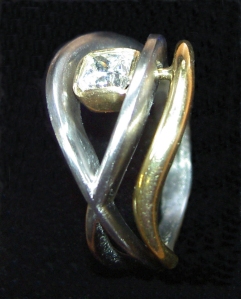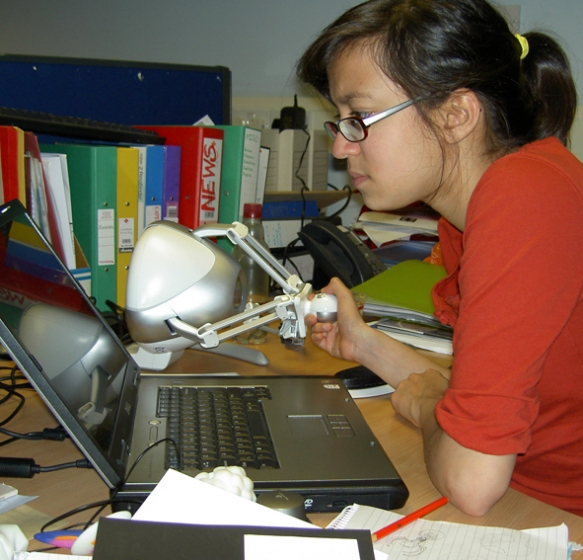It has been an amazing year for 3D printing and there are some interesting threads on various blogs to follow on through.
A year ago Fabbaloo posted their “wishes for 2010” and one was for Easy 3D Software as the packages on offer do require a lot of learning to become fully capable. My issue with most is that they have un-needed complexity. With too many functions also cluttering up the interface many are put off by the steep learning curve and thereby exclude from access to 3D printing. In Fabbaloo’s wish list there were 2 developments in 2010 they noted that improve the position:
Anarkik3D’s haptic based 3D design software is
Cloud9 and our distributor (A1 Technologies) imports the Falcon haptic device from Novint in the United States, bundles the software and device together and markets the package as
Chameleon. Another blog (RPES blog) on August 10th covered the designer jewellery created by Farah Bandookwala during her Master’s Degree at Edinburgh College of Art. I have already written about Farah’s work in this blog as she had a residency with us in Summer 2009 to investigate using Cloud9 for her work and we have worked closely with her since then.
To quote from Rachel’s blog: ‘Using Chameleon alongside a traditional 3D CAD package, Rhino, Farah found that the differences between the two software packages were extreme. Most notable was that while the 3D CAD offered control and precision with surfaces, it just could not compare with the ability to freely sculpture the shapes by directly deforming and manipulating surfaces to create the desired morphing. Indeed it is the freedom of the software that is one of the greatest attractions for truly creative design, with no constraints.‘
Farah secured sponsorship with Shapeways and LaserLines to have her designs 3D printed, from concept stage where she experimented with constructions and fastenings, through to the dyed and finished pieces into which she embedded magnets as connectors.
Farah’s work proves that Fabbaloo’s ‘easy 3D software’ wish for 2010 is here already, as Cloud9 has levels of usability and functionality that are balanced, a rubust .stl format for 3D printing (of course) and compatibility with CAD, it is affordable (£495 with the Falcon haptic device) and it is available (A1 Technologies).
Replicator’s blog on December 23, 2010 about ‘Who is Getting Interested in 3D Printing? Server Log Stories‘ by Joseph Flaherty says that, yes, ‘3D printers are an amazing technology, but haven’t yet broken into the mainstream. Largely because companies haven’t figured out a way to profitably employ them. Yet. However, based on my Google Analytics I can see some interesting companies are looking into the technology. These are big companies and if they apply 3D printing to their businesses it will make for some really awesome products.’
I am interested in Joseph’s focus on Fire Mountain Gems‘ an ecommerce powerhouse that serves the multibillion dollar home jewelry making market. Using their catalog and online shopping carts crafters crank out beautiful pieces of jewelry. It seems though that the folks at Fire Mountain might be interested in how 3D printing could expand their service offering’. How I agree, as I am sure would Farah, as 3D printing materials are developing fast with steel, ceramics and glass now available at Shapeways, expanding the plastics, nylons, and starches, the range of colours, and resolutions now on offer. We will watch with interest and expect to see a category for 3D printed beads in Fire Mountain Gems catalogue!
On Anarkik3D’s blog I am covering an Mcor/Anarkik3D project as Cloud9’s capability for organic forms, combined with 3D printing in layers of coloured paper using Mcor’s Matrix printer, will illustrate beautifully the potential their technology has for designers. I am particularly interested in the use of actual 3D printed pieces as end products.
Joris Peel’s blog at Materialise has a review of the highlights of 2010 and is well worth reading. His clips for November 23rd cover .MGX opening its flagship store in Brussels, the world’s first store for 3D printed goods.
This area of ‘off-the-machine’ making is now a very exciting, well established state of things, with great designs available from a growing number of companies and individuals. One major example – see the FOC Collection
What would Fabbaloo wish to happen in 2011?
· A capable and assembled 3D printer for under USD$1500. Yes, especially for early concept work.
· A consumer-oriented online market for 3D models. I agree with them that Thingiverse is oriented around makers, not consumers. Shapeways and Ponoko’s business models could be tweaked to develop a more consumer orientated online resource but Sculpteo has with its company name more potential to attract those customers who are seeking more ‘desirable’ less techie things to 3D print.
It would be good to have somewhere appropriate to put out some 3D Cloud9 designs as .stl that others can access and get printed – as Fabbaloo says ‘Things They Like. Not things that engineers like to print’. I have put one (my apple and worm) on our Anarkikangels’ website – maybe we should have more!








